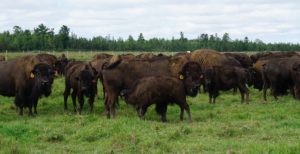
Circle K Ranch is home to over 250 head of American plains and Canadian woods buffalo.
By Savannah Halleaux, Michigan Farm Service Agency
Orv Kabat is a rancher who raises bison in Michigan’s Upper Peninsula. In its 30th year of business, Orv’s Circle K Ranch provides meat to about 30 restaurants and health food stores across the state, while ensuring cleaner water flows downstream.
Growing the Herd
Circle K Ranch is home to over 250 head of American plains and Canadian woods bison, or commonly called buffalo.
“We’re not very big at all. We probably process 50-60 animals a year, but we are growing,” Orv said. “The market is there for it. It’s just growing the herd, which is what we’re doing right now.”
Initially, the location of the ranch posed a challenge to Orv’s hopes to increase buffalo production.
“This is a unique spot right here,” said Orv. “It looks flat, but some of it actually tips east to the Munoscong River. Just a few hundred feet to the west of us, the land tips to the Pine River. You have to be cautious about what you are doing here, because it has implications for the Great Lakes.”
The runoff from the land inevitably feeds directly into the Great Lakes, which holds over 20 percent of the world’s fresh water.
Creating a Buffer
Orv reached out to the USDA Service Center in Chippewa County for guidance and assistance to manage his livestock while protecting water sources. The Farm Service Agency and Natural Resources Conservation Service provided technical support and financial assistance through the Grassland Reserve Program, now the Agricultural Conservation Easement Program, and the Conservation Reserve Program.
“It is important to keep cattle out of the water that flows directly into the rivers,” said Kaye Vining, county executive director for the Farm Service Agency in Chippewa County. “The idea is to back the buffalo off the water sources and drains that go into the watershed to prevent bio-contaminants (waste) and nutrients from leeching in.”
By planting herbaceous vegetation, buffer strips are created to slow water flow and force contaminants like sediment, chemicals, and nutrients to collect in vegetation. Collected nutrients and chemicals are used by vegetation before they enter water bodies.
USDA was involved in the process from the initial consultation followed by site visits, land management consultations, developing fencing plans, creating water system designs, and inspecting construction.
The USDA programs provided cost-share to build fences, keeping the buffalo out of the watershed water sources and to create buffer strips between the buffalo and drains.
Other Assistance

Circle K Ranch’s location posed a challenge to his hopes of increasing his buffalo production.
Removing the buffalo from the natural water source also qualified Orv for cost- share on an environmentally-safe watering system through the Conservation Reserve Program.
“It is taking the buffalo out of vulnerable water sources and giving them somewhere else to get water,” he said.
The program provided cost-share funding for two 2,800-gallon tanks at the ranch. These tanks feature steel-reinforced concrete, wells to supply water, automatic float-valve shutoffs, and anti-flow-back devices to protect the groundwater from contamination.
“All of the folks have been very cooperative,” said Orv. “We are delighted to be a part of CRP and to participate in the program.”
Circle K Ranch also participates in the Noninsured Crop Disaster Assistance Program through the Farm Service Agency for hay and pasture. This program provides financial assistance to producers of noninsurable crops to protect against natural disasters that result in lower yields or crop losses. This program is particularly important to Circle K Ranch because the buffalo feed off the forage year-round.
More Information
USDA offers a variety of risk management, disaster assistance, loan, and conservation programs to help agricultural producers in the United States weather ups and downs in the market and recover from natural disasters as well as invest in improvements to their operations. Learn about additional programs.
For more information about USDA programs and services, contact your local USDA service center.
JOIN THE CONVERSATION
For the digital version of this blog, visit #FridaysOnTheFarm.
Follow the #FridaysOnTheFarm story series and other news you can use on farmers.gov and @Farmersgov Twitter.





